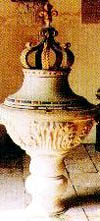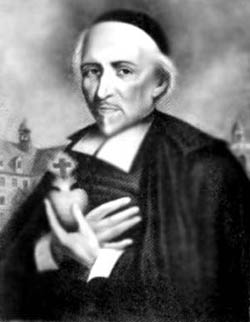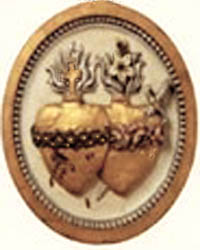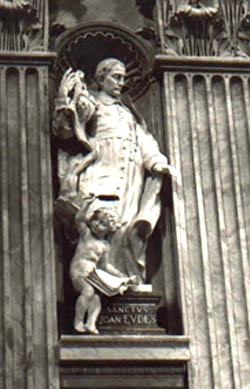 |
The Saint of the Day
St. John Eudes, August 19
Prof. Plinio Correa de Oliveira
Biographical selection:

The font where St. John Eudes was baptized
|
St. John Eudes was born in 1601 in the village of Ri, Normandy, France, to pious parents who consecrated him to the Holy Virgin. In 1615 he made a vow of chastity while he was studying with the Jesuits of Caen. On that occasion he consecrated himself to Mary, and from then was notable for his fervent devotion to her.
He left the Jesuits to enter the Congregation of the Oratory, founded by the famous Fr. Pierre de Berulle, who worked to re-establish orthodoxy of doctrine and sanctity of life among the clergy. St. John Eudes thought that the training of priests should also be a priority, so in 1643, he left the Oratory and founded the Society of Jesus and Mary (the Eudists Fathers) to specialize in seminary education. Its first seminary opened in Caen, shortly followed by many others.
In order to convert women of ill-fame and assist those who had converted from a wayward life, he founded another institution, the Congregation of Our Lady of Charity. He also instituted the parish mission to evangelize the neglected souls. For long years, he preached to large crowds in churches or the open fields, or in the courts of nobles and the King. His sermons were known for his strong condemnation of the vices of his audience and their great eloquence supported by his eminent sanctity.
He spread the devotion to the Sacred Hearts of Jesus and Mary, and was responsible for getting the church to accept liturgical offices in its honor. Always faithful to the Chair of Peter, he was persecuted by the Jansenists, whom he counter-attacked with energy.
He died August 19, 1680, pronouncing the names of Jesus and Mary.
Comments of Prof. Plinio:
There is a parallel between the spiritual and the juridical work developed by St. John Eudes during his lifetime.

St. John Eudes
|
He lived, as you just heard, in a Catholic country, France. His mission was not to combat the declared, external enemies of the Church, but rather to try to restore the fervor of tepid Catholics.
The country at that time was suffering a profound religious crisis from which the French Revolution was born. This religious crisis had its substance in the fact that love of God and true fervor had almost disappeared in the souls of the people, and the Catholic sense of the faithful had dimmed.
Divine Providence, wanting to avoid the coming tragedy of the French Revolution and, above all, the apostasy that it represented, called great souls in different ways to reignite Catholic fervor in France. Many saints of the 17th and 18th centuries were zealous and fiery souls. They were not characteristically great theologians, but saints whose role was to spread the love of God and stoke the coals that still smoked and fan them into burning flames.
Among such souls, you have St. Vincent de Paul who was a man with an incandescent love of God and St. Francis of Sales who spread a profound love of God in the highest levels of society. But, in particular, there were two fundamental burning fires at that time:
• The work of St. Louis Grignion de Monfort in the 18th century in the Vendée and Bretagne, which gave birth to the Chouannerie;
• and the work of St. John Eudes, which we are commenting on now.
Anyone who reads the revelations of St. Margaret Mary Alacoque sees that the goal of those apparitions was to inaugurate devotion to the Sacred Heart of Jesus. One of its main characteristics was to move tepid Catholics out of their their tepidity, to light the love of God in souls that had cooled. St. Margaret Mary received that devotion as a great treasure, but she was a Visitation religious who could not leave her convent. Her mission was to record the devotion, practice it, and become a saint. Her canonization was a confirmation and approval of the Church for that devotion.

The Sacred Hearts of Jesus and Mary
|
St. Margaret Mary wrote to King Louis XIV of France telling him to consecrate France to the Sacred Heart of Jesus and place the Sacred Heart on the flag of France. The King refused to do both things. The result: the royal power deteriorated in France. When Louis XVI was a prisoner in the Temple in 1792, he finally made that consecration, but he did it without the adhesion of the French people. He still had the de jure power to make the consecration, but no longer a de facto power. It was already too late.
St. Margaret Mary also wrote to missionary priests to make them aware of the devotion, and it began to spread in pious circles. One of those who heard about it was St. John Eudes, who soon after embarked on his great work as the apostle of the devotion to the Sacred Hearts of Jesus and Mary.
A great orator, he founded a new congregation hoping that, with the prestige of his sanctity and the work of that institution, the devotion would take off in France. But this did not happen. There was another refusal of grace. This time it was not the refusal of the King, but the hardness of heart of the French people. The devotion made little impression and did not raise great enthusiasm. The writings of John Eudes, who became a saint, formed the basis for a generalized devotion to the Sacred Hearts in the 19th century, but the 18th century did not accept that devotion. He was a kind of rejected prophet who fought with all his strength unsuccessfully against the tepidity of the French Catholics.

St. John Eudes in St. Peter's Basilica, the Vatican
|
To fight against such tepidity, he used juridical methods in parallel with spiritual ones. Seminaries were nonexistent in France, so he founded seminaries. In this way, the men studying to be priests could be removed from their families and formed in a fervent ambience so that when they were ordained priests, they would be enthusiasts of that devotion, with no links to world. The seminaries – until they became the sad reality we see today – were a truly admirable thing for the formation of the clergy. They acted as a lever to restore the Catholic spirit in Europe in the 19th century.
You see, then, a saint who fought against tepidity in two ways: spiritually, by founding a congregation destined to spread this devotion; and juridically, by founding a new way of teaching and forming the clergy that existed in thesis, but was not yet a fact in France.
What does the life of St. John Eudes teach us? I think that one of the most dangerous things for a counter-revolutionary is to become mediocre and tepid. To become a person who no longer cares about the great panoramas and the grand needs of our cause, but one who just wants to live his petty life with its small pleasures. In many ways, this is more dangerous than depraved movies, immoral magazines, and bad company, because it corrodes the very core of the love of God in a soul. Such a spirit of mediocrity and tepidity makes a person insensible to the Passion of the Church in our days and the grandeur of the fight to save the Church from her enemies. No Lepanto, no Covadonga, just the small pleasures of the little life of self.
The devotion to the Sacred Hearts of Jesus and Mary is an adequate means to correct such a spirit. If we have this problem, or even this temptation, we should pray to the Sacred Hearts of Jesus and Mary to restore us to fervor. It is the specific remedy for such a serious illness. We should also ask the patronage of St. John Eudes to achieve this objective.


  | | Prof. Plinio Corrêa de Oliveira | |
The Saint of the Day features highlights from the lives of saints based on comments made by the late Prof. Plinio Corrêa de Oliveira. Following the example of St. John Bosco who used to make similar talks for the boys of his College, each evening it was Prof. Plinio’s custom to make a short commentary on the lives of the next day’s saint in a meeting for youth in order to encourage them in the practice of virtue and love for the Catholic Church. TIA thought that its readers could profit from these valuable commentaries.
The texts of both the biographical data and the comments come from personal notes taken by Atila S. Guimarães from 1964 to 1995. Given the fact that the source is a personal notebook, it is possible that at times the biographic notes transcribed here will not rigorously follow the original text read by Prof. Plinio. The commentaries have also been adapted and translated for TIA’s site.
|
Saint of the Day | Home | Books | CDs | Search | Contact Us | Donate

© 2002- Tradition in Action, Inc. All Rights Reserved
|
 |

|